|
Manufacturing process is one of the most dedicate process of the production of the carpet and rug. There are various stages involved in the manufacturing process of carpets and rugs. However, from the sorting of the wool to the packaging stage of the finished product is carried out by hand. And the dexterity of hand plays a key role for the fine finishing of carpet and rug. Besides that, a carpet and rug goes through following stages as outlined below.

Hand Spinning of woolen yarn is an age old traditional occupation of Nepalese dating back to ancient time when there was no modern machinery to produce yarn for local handloom textile meet the indigenous demand. Hand spinning of woolen yarn is more popular among the indigenous Tribe of the hilly region of Nepal which provided employment to the uneducated & small skilled Nepalese people.
Nepalese carpet is a hand knotted pile carpet. The woolen yarn used by the carpet industries for the pile is all hand spun. The use of hand spun yarn is a traditional of the Nepalese carpet industries which provides different look and unique characteristics to the carpet.

Color Dyed Wool
|
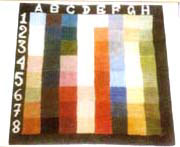
Color Chart
|
Wool Sorting
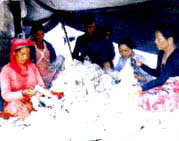 Wool sorting process is essential for the wool, which is imported from Tibet in raw form, to isolate foreign particles such as grease, as a natural impurity and vegetable matter, sand, dirt etc. The Tibetan wool has a strong good fibre, good lustre and a high resilient value. The wool imported from New Zealand does not need sorting and washing as it is already scoured. The washing process, with the chemicals, is known as scouring.
Wool sorting process is essential for the wool, which is imported from Tibet in raw form, to isolate foreign particles such as grease, as a natural impurity and vegetable matter, sand, dirt etc. The Tibetan wool has a strong good fibre, good lustre and a high resilient value. The wool imported from New Zealand does not need sorting and washing as it is already scoured. The washing process, with the chemicals, is known as scouring.
Hand Carding
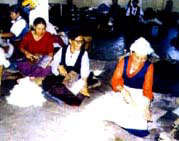 Hand Carding is a process in which wool fibres are opened and separated and each fibre is set in a straight position. Carding process enhances the fibre to stand to flow when spinning, which helps to produce uniform yarn of desired thickness. Blending different wools is done in this stage. Traditionally, carding was carried out by hand and machine carding was introduced when the industry thrived. Depending on the choice of the customer, hand carded product is still available.
Hand Carding is a process in which wool fibres are opened and separated and each fibre is set in a straight position. Carding process enhances the fibre to stand to flow when spinning, which helps to produce uniform yarn of desired thickness. Blending different wools is done in this stage. Traditionally, carding was carried out by hand and machine carding was introduced when the industry thrived. Depending on the choice of the customer, hand carded product is still available.
Wool Spinning
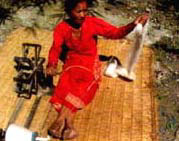 The carded wool is spun into yarn in different ways by using various means. It can be spun by using hand driven spinning wheel, foot and hand driven spinning wheel. The thickness of the yarn depends on the quality of the carpet and generally a 3-ply yarn is used.
The carded wool is spun into yarn in different ways by using various means. It can be spun by using hand driven spinning wheel, foot and hand driven spinning wheel. The thickness of the yarn depends on the quality of the carpet and generally a 3-ply yarn is used.
Dyeing
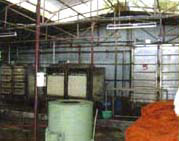 Generally, two methods of dyeing are in practice: the traditional and the modern. The traditional method, which is also known as pot dyeing, is a method in which a pot, made of copper or aluminium is used. The modern method, which is a machine operated, is a closed dyeing method. The dyeing vessels or pots are made of steel. Both manual and machine dyeing, processes need the same dyeing chemicals and dyes as per the recipe and the shade needed. Then, the dyed yarn is dried in the sun.
Generally, two methods of dyeing are in practice: the traditional and the modern. The traditional method, which is also known as pot dyeing, is a method in which a pot, made of copper or aluminium is used. The modern method, which is a machine operated, is a closed dyeing method. The dyeing vessels or pots are made of steel. Both manual and machine dyeing, processes need the same dyeing chemicals and dyes as per the recipe and the shade needed. Then, the dyed yarn is dried in the sun.
Balling
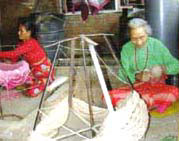 After the dyed yarn hand is properly dried, it is rolled into balls of threee ply yarn for each colour. The balling is done manually and is necessary for the carpet weaving.
After the dyed yarn hand is properly dried, it is rolled into balls of threee ply yarn for each colour. The balling is done manually and is necessary for the carpet weaving.
Weaving / Knotting
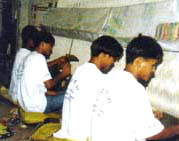 Weaving / Knotting is a state of art. A well-trained weaver, who is highly skilled in knotting art. One or more weavers work on a loom depending on the size of the carpet. Each weaver makes individual knots row after row. The knotting starts with the help of a graph. The design of the carpet is drawn on a graph paper and hands downs from the top of the loom, or is unrolled, row-by-row as a guide to the weaver. Iron rod, liver, comb beater are used as tools.
Weaving / Knotting is a state of art. A well-trained weaver, who is highly skilled in knotting art. One or more weavers work on a loom depending on the size of the carpet. Each weaver makes individual knots row after row. The knotting starts with the help of a graph. The design of the carpet is drawn on a graph paper and hands downs from the top of the loom, or is unrolled, row-by-row as a guide to the weaver. Iron rod, liver, comb beater are used as tools.
Trimming
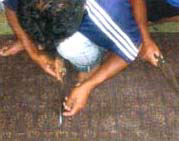 Once the carpet is complete, it is removed from the loom and put on a flat surface. Then it is trimmed with the help of the scissors and carved out the desired designed and patterns.
Once the carpet is complete, it is removed from the loom and put on a flat surface. Then it is trimmed with the help of the scissors and carved out the desired designed and patterns.
Washing and drying
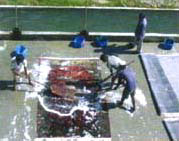 The trimmed carpet is washed with fresh water chemicals. The sole purpose of washing is to clean and improve natural lustre of wool and these are achieved through removing surface dirt and excess dye. Then the washed carpet is dried in the sun light up to four to five days.
The trimmed carpet is washed with fresh water chemicals. The sole purpose of washing is to clean and improve natural lustre of wool and these are achieved through removing surface dirt and excess dye. Then the washed carpet is dried in the sun light up to four to five days.
Stretching
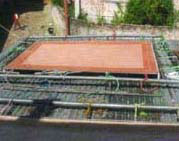 During the washing process, a carpet may be deformed in shape. To bring the carpet back to its proper shape, it is stretched across all the sides and left for certain hours. Stretching is carried out for only those carpets that are undergone deformation during washing.
During the washing process, a carpet may be deformed in shape. To bring the carpet back to its proper shape, it is stretched across all the sides and left for certain hours. Stretching is carried out for only those carpets that are undergone deformation during washing.
Finishing
The dried and stretched carpet is thoroughly checked, and given a final finishing touch by re-trimming if necessary. The carpet is selected for export afterwards.
|







 Wool sorting process is essential for the wool, which is imported from Tibet in raw form, to isolate foreign particles such as grease, as a natural impurity and vegetable matter, sand, dirt etc. The Tibetan wool has a strong good fibre, good lustre and a high resilient value. The wool imported from New Zealand does not need sorting and washing as it is already scoured. The washing process, with the chemicals, is known as scouring.
Wool sorting process is essential for the wool, which is imported from Tibet in raw form, to isolate foreign particles such as grease, as a natural impurity and vegetable matter, sand, dirt etc. The Tibetan wool has a strong good fibre, good lustre and a high resilient value. The wool imported from New Zealand does not need sorting and washing as it is already scoured. The washing process, with the chemicals, is known as scouring.
 Hand Carding is a process in which wool fibres are opened and separated and each fibre is set in a straight position. Carding process enhances the fibre to stand to flow when spinning, which helps to produce uniform yarn of desired thickness. Blending different wools is done in this stage. Traditionally, carding was carried out by hand and machine carding was introduced when the industry thrived. Depending on the choice of the customer, hand carded product is still available.
Hand Carding is a process in which wool fibres are opened and separated and each fibre is set in a straight position. Carding process enhances the fibre to stand to flow when spinning, which helps to produce uniform yarn of desired thickness. Blending different wools is done in this stage. Traditionally, carding was carried out by hand and machine carding was introduced when the industry thrived. Depending on the choice of the customer, hand carded product is still available.
 The carded wool is spun into yarn in different ways by using various means. It can be spun by using hand driven spinning wheel, foot and hand driven spinning wheel. The thickness of the yarn depends on the quality of the carpet and generally a 3-ply yarn is used.
The carded wool is spun into yarn in different ways by using various means. It can be spun by using hand driven spinning wheel, foot and hand driven spinning wheel. The thickness of the yarn depends on the quality of the carpet and generally a 3-ply yarn is used.
 Generally, two methods of dyeing are in practice: the traditional and the modern. The traditional method, which is also known as pot dyeing, is a method in which a pot, made of copper or aluminium is used. The modern method, which is a machine operated, is a closed dyeing method. The dyeing vessels or pots are made of steel. Both manual and machine dyeing, processes need the same dyeing chemicals and dyes as per the recipe and the shade needed. Then, the dyed yarn is dried in the sun.
Generally, two methods of dyeing are in practice: the traditional and the modern. The traditional method, which is also known as pot dyeing, is a method in which a pot, made of copper or aluminium is used. The modern method, which is a machine operated, is a closed dyeing method. The dyeing vessels or pots are made of steel. Both manual and machine dyeing, processes need the same dyeing chemicals and dyes as per the recipe and the shade needed. Then, the dyed yarn is dried in the sun.
 After the dyed yarn hand is properly dried, it is rolled into balls of threee ply yarn for each colour. The balling is done manually and is necessary for the carpet weaving.
After the dyed yarn hand is properly dried, it is rolled into balls of threee ply yarn for each colour. The balling is done manually and is necessary for the carpet weaving.
 Weaving / Knotting is a state of art. A well-trained weaver, who is highly skilled in knotting art. One or more weavers work on a loom depending on the size of the carpet. Each weaver makes individual knots row after row. The knotting starts with the help of a graph. The design of the carpet is drawn on a graph paper and hands downs from the top of the loom, or is unrolled, row-by-row as a guide to the weaver. Iron rod, liver, comb beater are used as tools.
Weaving / Knotting is a state of art. A well-trained weaver, who is highly skilled in knotting art. One or more weavers work on a loom depending on the size of the carpet. Each weaver makes individual knots row after row. The knotting starts with the help of a graph. The design of the carpet is drawn on a graph paper and hands downs from the top of the loom, or is unrolled, row-by-row as a guide to the weaver. Iron rod, liver, comb beater are used as tools.
 Once the carpet is complete, it is removed from the loom and put on a flat surface. Then it is trimmed with the help of the scissors and carved out the desired designed and patterns.
Once the carpet is complete, it is removed from the loom and put on a flat surface. Then it is trimmed with the help of the scissors and carved out the desired designed and patterns.
 The trimmed carpet is washed with fresh water chemicals. The sole purpose of washing is to clean and improve natural lustre of wool and these are achieved through removing surface dirt and excess dye. Then the washed carpet is dried in the sun light up to four to five days.
The trimmed carpet is washed with fresh water chemicals. The sole purpose of washing is to clean and improve natural lustre of wool and these are achieved through removing surface dirt and excess dye. Then the washed carpet is dried in the sun light up to four to five days.
 During the washing process, a carpet may be deformed in shape. To bring the carpet back to its proper shape, it is stretched across all the sides and left for certain hours. Stretching is carried out for only those carpets that are undergone deformation during washing.
During the washing process, a carpet may be deformed in shape. To bring the carpet back to its proper shape, it is stretched across all the sides and left for certain hours. Stretching is carried out for only those carpets that are undergone deformation during washing.